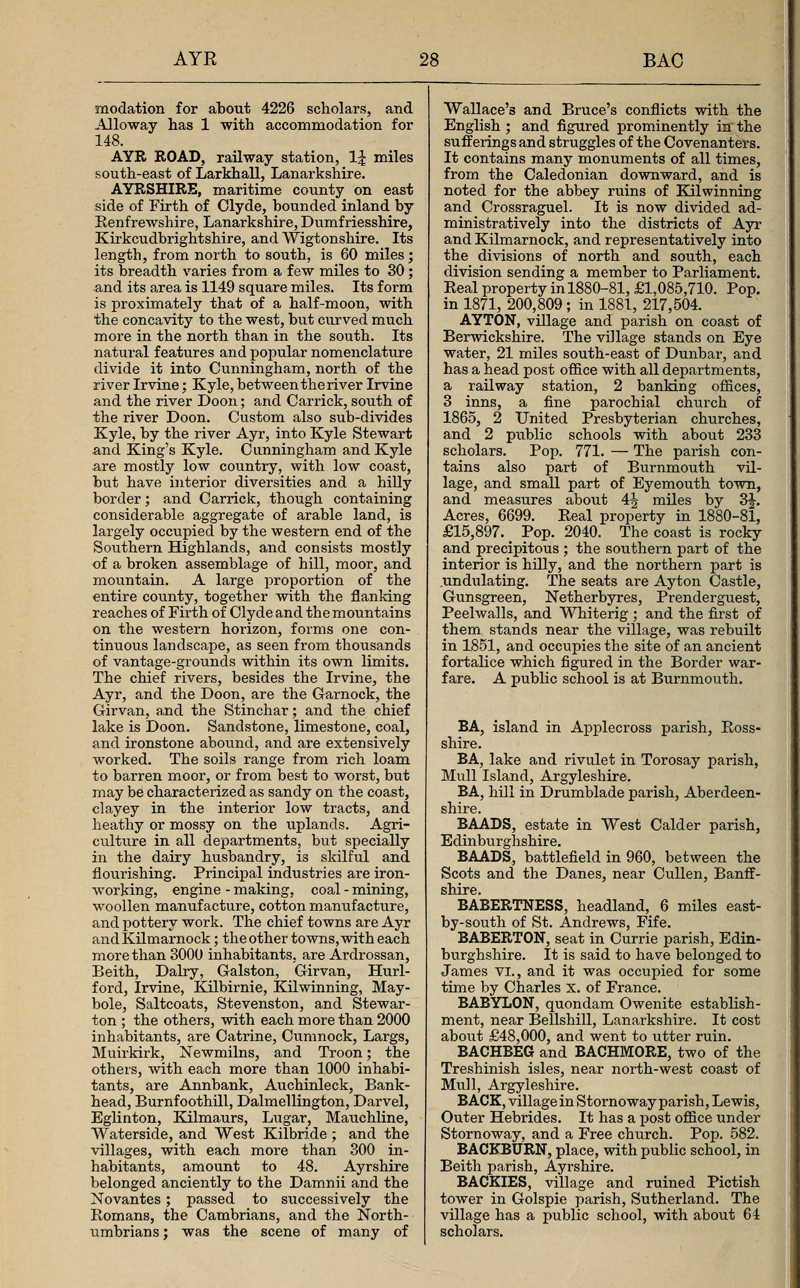AYR ROAD, railway station, 1 miles south-east of Larkhall, Lanarkshire.
AYRSHIRE, maritime county on east side of Firth of Clyde, hounded inland by Renfrewshire, Lanarkshire, Dumfriesshire, Kirkcudbrightshire, and Wigtonshire. Its length, from north to south, is 60 miles ; its breadth varies from a few miles to 30 ; and its area is 1149 square miles. Its form is proximately that of a half-moon, with the concavity to the west, but curved much more in the north than in the south. Its natural features and popular nomenclature divide it into Cunningham, north of the river Irvine ; Kyle, between the river Irvine and the river Doon ; and Carrick, south of the river Doon. Custom also sub-divides Kyle, by the river Ayr, into Kyle Stewart and King's Kyle. Cunningham and Kyle are mostly low country, with low coast, but have interior diversities and a hilly border ; and Carrick, though containing considerable aggregate of arable land, is largely occupied by the western end of the Southern Highlands, and consists mostly of a broken assemblage of hill, moor, and mountain. A large proportion of the entire county, together with the flanking reaches of Firth of Clyde and the mountains on the western horizon, forms one continuous landscape, as seen from thousands of vantage-grounds within its own limits. The chief rivers, besides the Irvine, the Ayr, and the Doon, are the Garnock, the Girvan, and the Stinchar ; and the chief lake is Doon. Sandstone, limestone, coal, and ironstone abound, and are extensively worked. The soils range from rich loam to barren moor, or from best to worst, but may be characterized as sandy on the coast, clayey in the interior low tracts, and heathy or mossy on the uplands. Agriculture in all departments, but specially in the dairy husbandry, is skilful and flourishing. Principal industries are iron-working, engine-making, coal-mining, woollen manufacture, cotton manufacture, and pottery work. The chief towns are Ayr ;i ml Kilmarnock ; the other towns, with each more than 3000 inhabitants, are Ardrossan, Keith, Dairy, Galston, Girvan, Hurlford, Irvine, Kilbirnie, Kilwinning, Maybole, Saltcoats, Stevenston, and Stewarton ; the others, with each more than 2000 inhabitants, are Catrine, Cumnock, Largs, Muirkirk, Newmilns, and Troon ; the others, with each more than 1000 inhabitants, are Annbank, Auchinleck, Bankhead, Burnfoothill, Dalmellington, Darvel, Eglinton, Kilmaurs, Lugar, Mauchline, Waterside, and West Kilbride ; and the villages, with each more than 300 inhabitants, amount to 48. Ayrshire belonged anciently to the Damnii and the Xovantes ; passed to successively the Romans, the Cambrians, and the North-umbrians; was the scene of many of Wallace's and Bruce's conflicts with the English ; and figured prominently in the sufferings and struggles of the Covenanters. It contains many monuments of all times, from the Caledonian downward, and is noted for the abbey ruins of Kilwinning and Crossraguel. It is now divided administratively into the districts of Ayr and Kilmarnock, and representatively into the divisions of north and south, each division sending a member to Parliament. Real property in 1880-81, 1,085,710. Pop. in 1871, 200,809 ; in 1881, 217,504.
AYTON, village and parish on coast of Berwickshire. The village stands on Eye water, 21 miles south-east of Dunbar, and has a head post office with all departments, a railway station, 2 banking offices, 3 inns, a fine parochial church of 1865, 2 United Presbyterian churches, and 2 public schools with about 233 scholars. Pop. 771. The parish contains also part of Burnmouth village, and small part of Eyemouth town, and measures about 4J miles by 3. Acres, 6699. Real property in 1880-81, 15,897. Pop. 2040. The coast is rocky and precipitous ; the southern part of the interior is hilly, and the northern part is .undulating. The seats are Ayton Castle, Gunsgreen, Netherbyres, Prenderguest, Peelwalls, and Whiterig ; and the first of them stands near the village, was rebuilt in 1851, and occupies the site of an ancient fortalice which figured in the Border war-fare. A public school is at Burnmouth.
BA, island in Applecross parish, Ross-shire.
BA, lake and rivulet in Torosay parish, Mull Island, Argyleshire.
BA, hill in Drumblade parish, Aberdeenshire.
BAADS, estate in West Calder parish, Edin burghshire.
BAADS, battlefield in 960, between the Scots and the Danes, near Cullen, Banffshire.
BABERTNESS, headland, 6 miles east-by-south of St. Andrews, Fife.
BABERTON, seat in Currie parish, Edinburghshire. It is said to have belonged to James vi., and it was occupied for some time by Charles x. of France.
BABYLON, quondam Owenite establishment, near Bellshill, Lanarkshire. It cost about 48,000, and went to utter ruin. BACHBEG and BACHMORE, two of the Treshinish isles, near north-west coast of Mull, Argyleshire.
BACK, village in Stornoway parish, Lewis, Outer Hebrides. It has a post office under Stornoway, and a Free church. Pop. 582.
BACKBURN, place, with public school, in Beith parish, Ayrshire.
BACKIES, village and ruined Pictish tower in Golspie parish, Sutherland. The village has a public school, with about 64 scholars.

